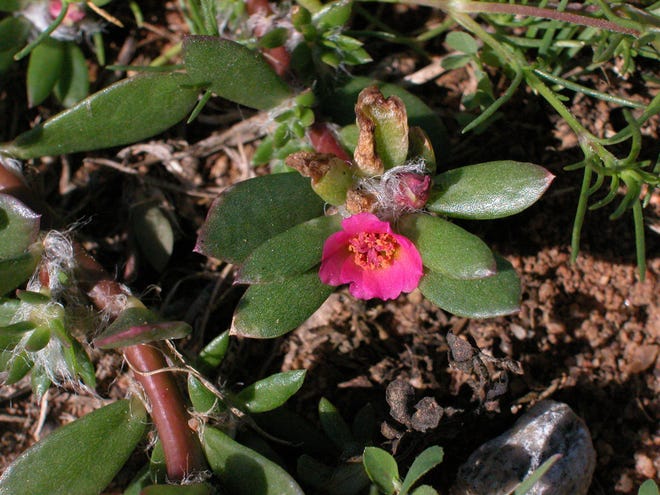Do you recognize this mysterious plant?
If only the flowers were a little bigger!
Five brilliant pink petals emerge from a discreet green calyx. Each vibrant flower contains about 10 to 12 prominent stamens, each with a bright yellow anther. The style is divided at its top into a number of branches, usually five or six, and these radiate outwards, forming a sort of star-shaped pattern.
This beautiful little flower is hard to miss when fully open, and it only happens on sunny days, as the flowers don’t like cloudy or rainy weather. Once the flowers open, however, the petals don’t last long, and after about a day they and the rest of the flower sag into a small mess, which eventually dry up and fade away.
What would be left would be a rounded, plump, green capsule, and only about half an inch long. The round capsule opens in an unusual way: instead of opening at the sides along lines (like most capsules), the top half separates cleanly, like a small pointed lid. Or like the pointed cap of a little garden elf.
There are lots of very small black seeds inside, and once the lid is removed from the capsule, the seeds scatter quickly. These seeds spread easily, being so small, and it is for this reason that the plants move easily.
This particular species is a native plant to South America, and of course that means it is introduced here in the southeast. Researchers have postulated that it first appeared in North Carolina in the 1930s. Since then it has spread to Virginia and Florida, and there now appear to be reports from Mississippi.
It is basically a weed, commonly seen on sandy soils, often in agricultural settings, and apparently enjoying those hot (and often dry) summers. It is an annual, blooming all summer and into autumn, spreading by those little seeds, and one might reasonably expect it to end up elsewhere. The stems can be flat on the ground or somewhat raised, thus forming plates.

This plant has about 10 close relatives in North America, and there are many more around the world, perhaps a hundred. Some have yellow rather than pink flowers. Some of them are popular as a food source, and the fresh leaves are frequently used raw and in salads, or cooked in soups.
You may notice a similarity between the flower pictured here and those of some hanging plants you can buy at a garden store. It is not a coincidence. Our little weed has several related cultivated varieties, but the cultivars always have larger flowers. And more of them.
So our beautiful little weed will have to be happy to show off its gorgeous blooms on the ground, several feet below most people’s eye level. Most of us would only pay attention to it by taking it out of the garden and throwing it in the compost. But the flowers are really pretty. You will need a magnifying glass to see them up close because this flower will never make a corsage out of them.
John Nelson is a retired curator of the AC Moore Herbarium at the University of South Carolina. A public service, the herbarium offers free plant identifications. For more information, visit www.herbarium.org or email [email protected].
Answer: Rose purslane, Portulaca amilis


Comments are closed.